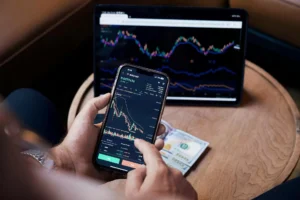The term “active stocks” refers to shares of companies that are heavily traded on the stock exchange. Active stocks are bought and sold frequently, which means that they have a fairly high trading volume. These stocks also tend to have a large number of shares outstanding. Because they are heavily traded, active stocks tend to have low bid ask spreads.
Active stocks allow investors to know the liquidity of these securities, the market’s opinion of these companies and the movement of prices: whether they will increase, decrease or remain unchanged. The term should not be confused with active investing, which is a completely different investment strategy and concept.
In a Nutshell
- Active securities are those that are often traded on an exchange or that see significant daily price volatility.
- Investors are able to learn about the securities’ liquidity, the market’s perception of the companies, and the price development of these assets.
- An active share cannot be determined by reference to a particular volume.
- The high trading volume of actively traded equities is driven by news, such as takeover offers for companies or positive profits, or by a high number of outstanding shares.
- The top gainers and losers, the most active stocks by index, the most active stocks by daily volume, and the largest trading volume are all displayed to investors in the lists of active stocks.
Understanding Active Actions
Active stocks typically have a large number of shares outstanding. Active stocks have a low bid ask spread and are usually considered to be highly liquid. This is because they trade a lot every day and are often available in large amounts. Active stocks tend to trade regardless of whether or not the share price fluctuates.
Stocks of companies listed in various indexes, such as the S&P 500, are generally considered active stocks. These are some of the largest companies in the United States (perhaps the world). Companies like Apple (AAPL), Microsoft (MSFT), AT&T (T), Amazon (AMZN) and Walmart (WMT) are active stocks because they all experience high daily trading volume.
Active stocks can also change over a period of time. Good news released by a company, such as a takeover bid, a new product launch or positive earnings, and/or positive economic data affecting a certain sector can lead to increased investor interest. This can lead to price swings and high trading volume, resulting in very active stocks.
As mentioned above, active equities should not be confused with active trading, which is a securities trading strategy. Traders who engage in active trading buy and sell securities to profit from short term price movements. Traders who actively trade do so through day trading, position trading, swing trading and scalping.
“I will tell you how to become rich. Close the doors. Be fearful when others are greedy. Be greedy when others are fearful.”
Warren Buffet
Indentify Active Stocks
There is no standard for how much a stock must trade in order to be considered active. Some analysts define “active stocks” as those that trade one to two million shares per day. On average, more than 250 stocks in the United States trade more than five million shares a day.
Although active values are usually indicated by volume, the term can also sometimes be applied to significant price movement, and most outlets will distinguish the difference between an active value based on volume and an active value based on price.
Exchanges and traders quote active stocks daily with the volume and profit or loss for the day. Stocks may be actively traded because they have a large number of shares outstanding or because of a special situation. For example, if there is a takeover bid for the company or because of unexpected news.
What to Keep in Mind when Using a List of Active Values
Active stock lists are an excellent way to help you with your investment strategy. You can find lists of the most active stocks updated in real time on numerous financial websites. These stocks typically fall into one of four categories:
- The stocks with the most shares traded
- The most gainers and losers by percentage, regardless of price or volume
- The highest daily volume, calculated by multiplying the value of the stock by the total number of shares traded that day
- The most active by index, such as the S&P 500
It is important to remember that these lists are indicative. Just because they are the most active stocks on a given day does not mean you should jump in and buy or sell all of their shares. Here are some factors to consider when incorporating these lists into your investment strategy:
- Shorten your list. Lists of active securities can be quite extensive. Figure out which one best suits your needs.
- Choose an index. Study the stocks that move the most and compare their percentage movements with those of some of the major indexes.
- Lists of most active stocks prior to trading can give you a good indication of what will happen during the trading day. If you are a day trader, you probably won’t be very interested in the after hours list.
- The most active stocks may expose you to more risk, so you need to decide if it’s worth it.
- The list of most active stocks by dollar volume is not something most people use unless they have a lot of capital.
Most Active Securities
Exchanges such as the New York Stock Exchange (NYSE) and Nasdaq offer daily listings of the most active stocks. They are usually limited to the 10 or 20 stocks with the highest trading volume on a given day. These lists are the same every day. They include stocks that are part of major indexes like the S&P 500.
The lists change daily as a result of market forces and are not limited to stocks. Bonds, currencies, exchange traded funds (ETFs) and futures regularly appear on the most active lists. They are attractive tools for traders of all experience levels. Day traders tend to focus on stocks with high volume and significant price fluctuations.
The three most active Nasdaq stocks by share volume on May 20, 2021 were Apple, Advanced Micro Devices (AMD) and Cisco Systems (CSCO). Technology stocks rose throughout the day on positive economic news. Fewer Americans filed jobless claims, the lowest since the 2020 COVID 19 crisis erupted.
Active securities may or may not appear in the most active securities lists.
Wrap Up
Active stocks are shares of publicly traded firms with a high trading volume and a narrow bid ask spread. These equities, which are regarded as being extremely liquid, offer data on the security’s liquidity, market sentiment, and price movement. It should not be confused with active trading, a method of trading stocks. A daily list of the most active stocks can be found on financial websites. The phrase “active stocks” can be defined by trading volume or price movement.
Before adopting these lists into your investment strategy, it’s crucial to take into account elements like risk and market movements. Daily lists of the most active stocks, which may include stocks, bonds, currencies, ETFs, and futures, are provided by exchanges like the NYSE and Nasdaq. Due to market factors, the most active stocks in terms of share volume fluctuate everyday.
FAQs

Active trading is an investment strategy. Traders who engage in active trading do so to profit from short term changes in security prices. Day trading is an active strategy intended for very experienced traders who buy and sell securities in a single day. Most day traders are well funded and use leverage to profit from short term changes in security prices.
What is the difference between active trading and day trading?
Active trading is an investment strategy. Traders who engage in active trading do so to profit from short term changes in security prices. Day trading is an active strategy intended for very experienced traders who buy and sell securities in a single day. Most day traders are well funded and use leverage to profit from short term changes in security prices.
Social networks can be an excellent way to search for and identify active stocks. You can use sites such as Twitter, which provides users with trending topics. This can help you determine market signals and how breaking news influences and moves stocks.
As with any other investment tool or strategy, it is important to do your due diligence and take the information you find on the Internet with caution. Just because it may look like a big move on social media, that doesn’t necessarily mean it is. Always do your research.
Article sources
At Capital Maniacs, we are committed to providing accurate and reliable information on a wide range of financial topics. In order to achieve this, we rely on the use of primary sources and corroborated secondary sources to support the content of our articles.
Primary sources, such as financial statements and government reports, provide firsthand evidence of financial events and trends. By using primary sources, we are able to directly reference information provided by the organizations and individuals involved in these events.
Secondary sources, such as financial analysis and commentary, interpret and analyze primary sources. While these sources can be useful for providing context and background information, it is important to use corroborated sources in order to ensure the accuracy and reliability of the information we present.
We take pride in properly citing all of our sources, both primary and secondary, in order to give credit to the original authors and to allow our readers to verify the information for themselves. We appreciate your trust in our website and are committed to upholding the highest standards of financial journalism.
- Yahoo! Finance – Stocks: Most Actives
- Trading Sim – 8 Things to Consider when using Most Active Stocks Lists
- Google Finance – Most Active Stocks
- Nasdaq – Most Active
- The Wall Street Journal – Tech Stocks Lead Rebound After Jobless Claims Drop





















